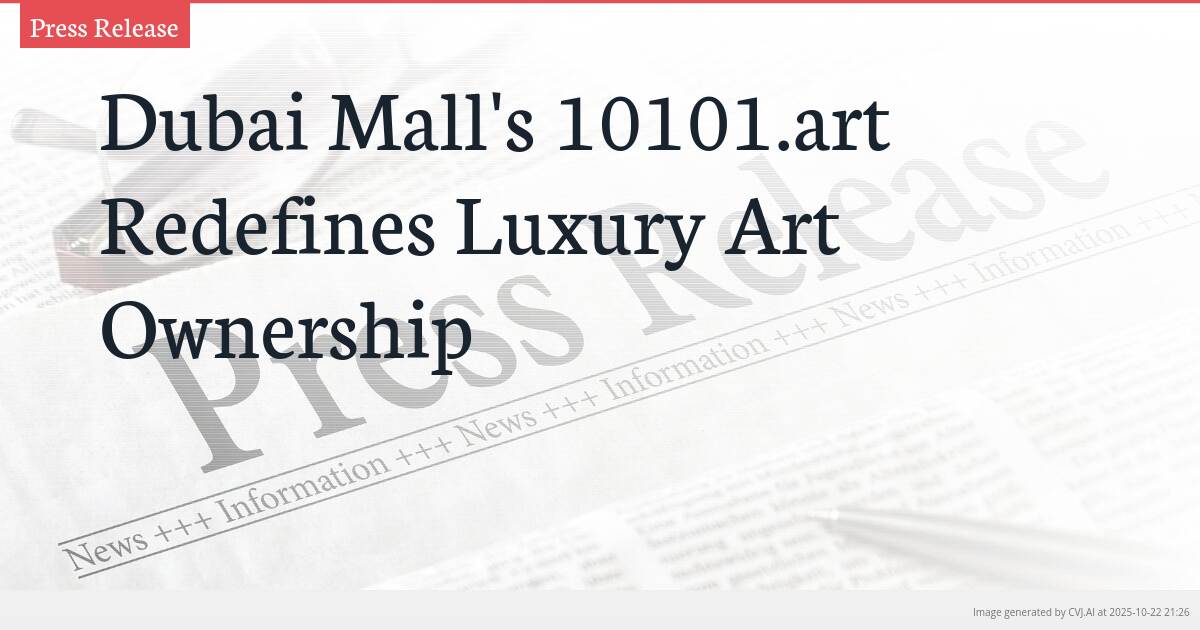This summary text is fully AI-generated and may therefore contain errors or be incomplete.
Introduction
A groundbreaking exhibition at Dubai Mall is transforming how we experience and own luxury art. 10101.art brings unseen masterpieces by Picasso, Dalí, and Warhol to the public while introducing fractional ownership through blockchain technology. This innovative approach democratizes art collecting while maintaining its exclusive appeal.
Key Points
- Exhibition features seven previously unseen masterpieces from private collections of artists including Picasso, Dalí, and Warhol
- Blockchain technology enables fractional ownership, allowing multiple collectors to co-own individual artworks through digital tokens
- Positioned within Dubai Mall's luxury retail environment, the exhibition redefines luxury as participatory cultural stewardship rather than mere ownership
The Cultural Milestone in Luxury Retail
In the heart of Dubai Mall, the world’s most visited retail destination, a new name has emerged among luxury icons like Rolex, Cartier, and Tiffany & Co. — 10101.art. From October 1-31, 2025, the Grand Atrium will host an unprecedented exhibition featuring seven previously unseen masterpieces by blue-chip artists including Picasso, Dalí, Warhol, Banksy, and Gus Van Sant. These works, once hidden in private collections, are now accessible to the public for the first time, representing a significant cultural milestone for Dubai.
The strategic location within Dubai Mall’s luxury retail environment is deliberate. By positioning fine art alongside established symbols of prestige, 10101.art places masterpieces within the same realm as high jewelry but with a transformative twist. For Dubai — a city synonymous with innovation, opulence, and cultural ambition — this exhibition represents more than just displaying art; it’s a statement about the evolving nature of luxury itself, where access and participation become as valuable as ownership.
Fractional Ownership: The New Face of Art Collecting
At the core of 10101.art’s innovation lies fractional ownership powered by blockchain technology. This model allows multiple collectors to co-own iconic artworks through transparent, secure, and legally recognized digital ownership. The system transforms art collecting from an exclusive pursuit reserved for the ultra-wealthy into a participatory experience where individuals can own fractions of cultural masterpieces.
The blockchain infrastructure ensures that ownership is transparent and secure, with each fractional share represented by digital tokens. This approach maintains the aura of exclusivity associated with blue-chip art while democratizing access. Collectors become cultural stewards rather than mere buyers, participating in the preservation and appreciation of significant artworks by artists like Picasso, Dalí, and Warhol. The model represents a fundamental shift in how value is perceived and transferred in the luxury art market.
Redefining Luxury in the 21st Century
10101.art represents a bridge between traditional art appreciation and cutting-edge ownership structures, reimagining what luxury means in the contemporary era. Rather than focusing solely on possession, this new model emphasizes shared cultural capital and meaningful participation. Owning a piece of Picasso or Warhol through 10101.art becomes a declaration of values — demonstrating curiosity, taste, and engagement with cultural heritage.
The initiative positions Dubai as a global hub for innovation at the intersection of art, technology, and luxury markets. By leveraging blockchain technology, 10101.art transforms what might otherwise be purely technical into something beautiful — a system that curates, preserves, and shares culture. This approach aligns with Dubai’s reputation as a crossroads of innovation and ambition, where traditional concepts of wealth display evolve into participatory cultural experiences that maintain their exclusive appeal while broadening accessibility.
📎 Read the original article on co.uk

